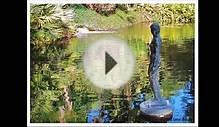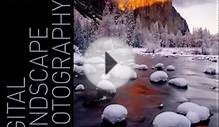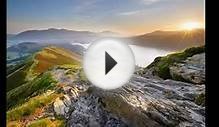
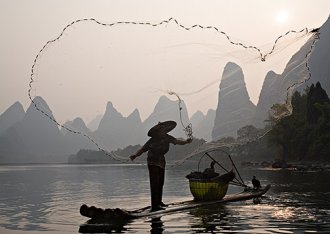 Net Casting. Guilin, China
Net Casting. Guilin, China
Canon 5D with 24-105mm f/4L IS lens @ ISOI 400
To landscape photographers the American southwest is the spiritual homeland. Yosemite, Arches and Zion National Parks figure among the archetypes. Beginning with the photographers of the 19th Century, and enshrined by Ansel Adams and his acolytes and imitators during the second half of the 20th Century, the national parks, deserts, and mountains of California, Nevada, Utah and Arizona have been the favoured destinations and prime subjects of legions of American landscape photographers.
But while contemporary fine-art landscape photography has its heart and greatest number of practitioners in America, there are other schools, and other venues. The world is a very large place, and America obviously has no monopoly on compelling landscapes. In this respect China and Japan stand apart, with equal fascination and rich histories.
Though in the West we see little of either historical or contemporary Chinese landscape photography, there is a rich history of Chinese landscape painting that is accessible though books and traveling exhibits. Through these, as well as an occasional visit over the years to art galleries and museums in Hong Kong and Tokyo, I became enamoured of the style of landscape painting and photography from these countries, and increasingly saw similarities between their esthetic and my own evolving style of working. It therefore increasingly became a desire of mine to visit some of the more famous locations in China. These included Guilin, famed for its gently weathered karst limestone hills, and Huangshan – the Yellow Mountains – instantly recognizable by their craggy and misty vistas, so often seen in classic Chinese paintings and pen and ink drawings.
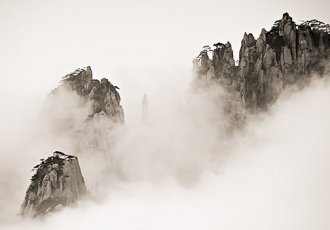 Though China has been a popular and reasonably accessible place for westerners to visit for the past two decades, it is such a vast country, and appropriate tourist infrastructure so limited outside of the more popular spots, that Western photographers have barely scratched the surface of China.
Though China has been a popular and reasonably accessible place for westerners to visit for the past two decades, it is such a vast country, and appropriate tourist infrastructure so limited outside of the more popular spots, that Western photographers have barely scratched the surface of China.
______________________________________________________
The Expedition
Just a short flight from Hong Kong, Guilin is one of the most popular tourist spots in China, visited by millions of people a year. The limestone hills in the region have a look almost unique in the world. The only other place with anything similar is in Vietnam, and on not nearly as large a scale.
The Li River runs though these hills and is the "highway" from which to see them. Literally hundreds of large and crowded tour boats ply the river each day.
From a photographers point of view the best time to shoot such landscape is early and late in the day. To make this work for us, and to avoid the crowds, we hired a small boat of our own, waking up at 4am in order to be at the right spot for sunrise. We had scouted the river in this boat the day before, doing a sunset shoot.
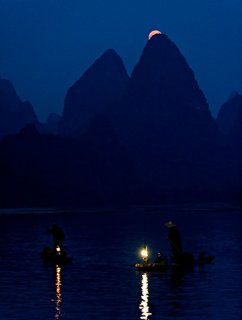 In addition to the natural beauty of the river, the other "feature" of the Li River are the traditional fisherman in their small boats, who work at night with lanterns on their boats, using tethered Cormorants to catch their fish.
In addition to the natural beauty of the river, the other "feature" of the Li River are the traditional fisherman in their small boats, who work at night with lanterns on their boats, using tethered Cormorants to catch their fish.
Photographs of them against this unique landscape are both picturesque and archetypal. They are also, I’m forced to say, in some ways fake. These fisherman work at night, not during daylight hours. Any photograph that you see of these fisherman also showing the landscape, and not done with flash, are therefore in some way set up.
Consequently we hired several fisherman, their boats, lanterns and cormorants, to work with us in setting up our shots. These are not actors. These are real fisherman, moonlighting if you will, and likely making more money from this outing than they would from a night’s fishing.
Now I know that some people will regard this as something of a cheat. So be it. But I don’t see it that way. Good photographs sometimes fall into ones lap. In the case of street and documentary shooting, this is always the case. But landscape and nature photographers almost always plan their shoots according to the time of year, seasons, weather, sun and moon positions, animal migration patterns, and the like. Making sure that all of the pieces are properly in place is part of the game.
For example, you’ll notice the full moon in the photograph immediately above. This was no accident. Our entire trip was scheduled to coincide with the full moon during the third week of October, 2005. This is something that I frequently make part of my shooting schedule, and if there’s no compelling reason not to schedule a shoot around the time of a full moon I always try and do so. Consequently people sometimes will comment on how lucky I was to have the moon in just the right place. Well, no. No luck was involved (other than weather). In the case of the shot above it took three months of planning, and scouting the location the day before with a GPS and ephemeris tables to pinpoint exactly when and where the moon would be located.
Huangshan
Misty Ridge. Huangshan, China. October, 2005
Canon 5D with 70-300mm f/5.6 DO IS @ ISO 100
I’m sure that at one time or another almost everyone has seen the iconic images of theYellow Mountainsof China, even if they weren’t aware of their name or location. Huangshan mountain, is, like Guilin, one of the most popular tourist areas in China. But it has only been so for about the past 20 years. Prior to 1975 the only way into this mountain fastness was by hiking arduous footpaths, and its only inhabitants isolated monks and hermits.
But today there are cable cars which carry visitors by the thousands each day to the several hotels that are scattered about the mountain tops. Once up there there are no vehicles of any kind. The only means of transport is by foot, along narrow but well maintained foot paths. There are porters available (not cheap) who will carry your bags from the cable car station to your hotel, and who actually carry all of the food and other consumables up and down the mountain.
YOU MIGHT ALSO LIKE
